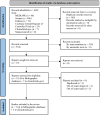Towards a core outcome set (COS) for intrinsic capacity (IC) intervention studies in adults in midlife and beyond: a scoping review to identify frequently used outcomes and measurement tools
- PMID: 38441748
- PMCID: PMC10914863
- DOI: 10.1007/s40520-023-02681-8
Towards a core outcome set (COS) for intrinsic capacity (IC) intervention studies in adults in midlife and beyond: a scoping review to identify frequently used outcomes and measurement tools
Abstract
This scoping review was conducted to identify the outcomes and measurement tools used in IC intervention studies, as first step towards the development of a core outcome set (COS) for IC trials. PRISMA-ScR and COS-STAD were followed. The review considered randomized controlled trials targeting IC published in Medline, Scopus, Embase, Cochrane Central Register of Controlled Trials, and clinicaltrials.gov, until June 2023. Of 699 references, 534 studies were screened once duplicates were removed, 15 were assessed for eligibility, and 7 (4 articles and 3 protocols) met eligibility criteria. Twenty-eight outcomes were identified (19 related to IC and its domains and 9 unrelated). The most reported primary outcome was the change in IC levels postintervention (5 over 7 studies) and the most reported outcomes (either as primary and/or secondary) were the changes in physical performance and in depressive symptoms (6 over 7 studies). Fifty-five tools used to construct the domains' z-scores and/or assess the effect of interventions were identified (47 related to IC and its domains and 8 unrelated). The most reported tool was an IC Z-score, calculated by 4 domains' z-scores: locomotor, vitality, cognitive, and psychological (5 over 7 studies). The tools differed among studies (10 locomotor related, 6 vitality related, 16 cognitive related, 8 psychological related, 6 sensorial related, 8 unrelated tools). The vast heterogeneity (28 outcomes and 55 tools within 7 studies) highlighted the need of a COS. These outcomes and tools will be presented to experts in a future step, to select the ones that should be taken into consideration in IC trials.
Keywords: Core outcome set; ICOPE; Intrinsic capacity; Older people; Scoping review.
© 2024. The Author(s).
Conflict of interest statement
DS-R, OB, Y-IR, and CB serve as Senior Advisors to the World Health Organization (WHO) Collaborating Center for Epidemiology of Musculoskeletal Health and Aging, Division of Public Health, Epidemiology, and Health Economics, University of Liège, Liège, Belgium. Y-IR serves as a member of the Board of Directors of the Clinical Consortium on Healthy Ageing (CCHA) of the WHO, Geneva, Switzerland. All authors declare they do not have any personal or financial relationships with other organizations or people that could inappropriately influence their work.
Figures








References
-
- Sánchez-Sánchez JL, de Souto Barreto P, Antón-Rodrigo I, et al. Effects of a 12-week Vivifrail exercise program on intrinsic capacity among frail cognitively impaired community-dwelling older adults: secondary analysis of a multicentre randomised clinical trial. Age Ageing. 2022 doi: 10.1093/ageing/afac303. - DOI - PMC - PubMed
Publication types
MeSH terms
LinkOut - more resources
Full Text Sources
Miscellaneous

